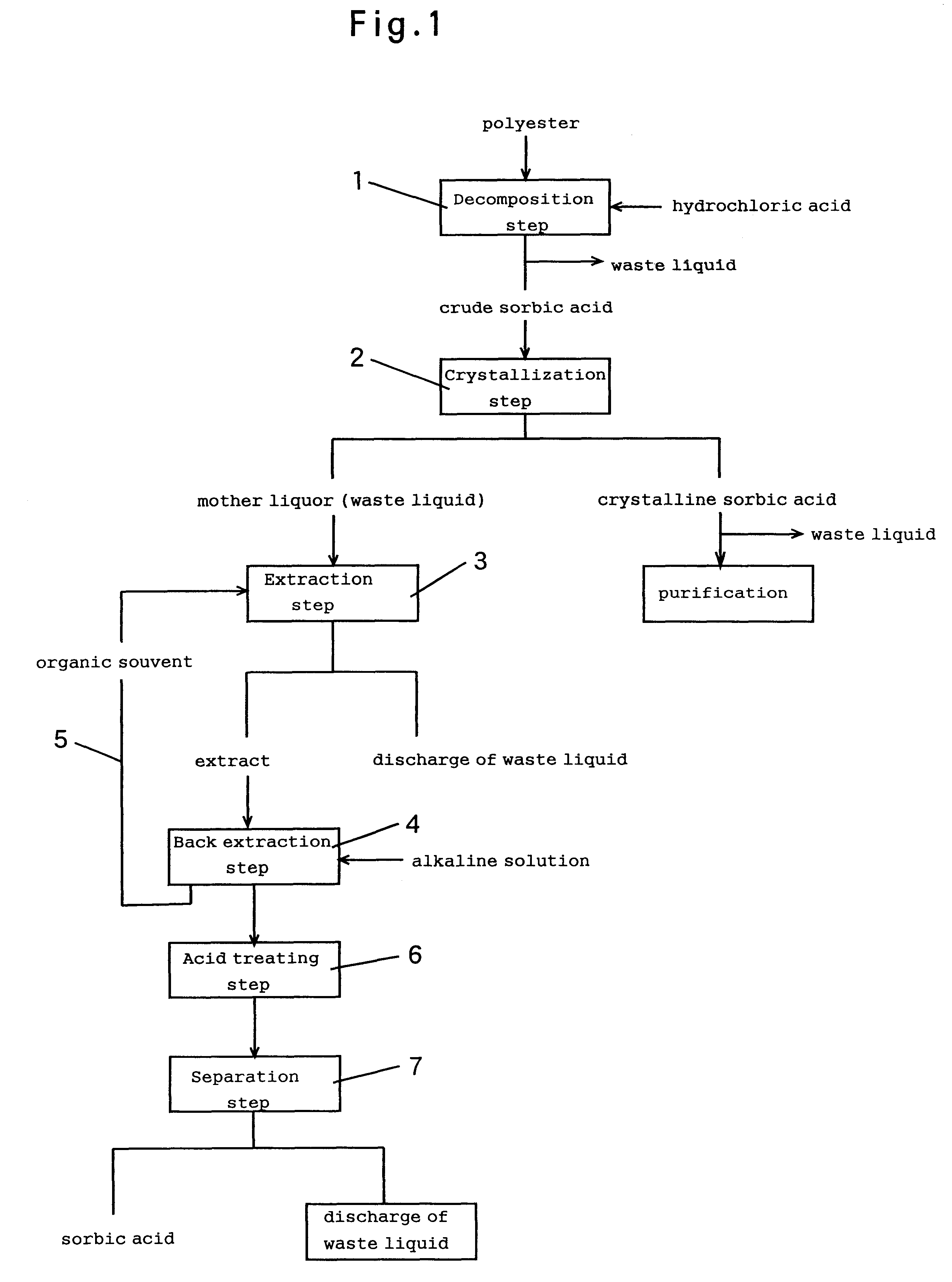Apparatus and method for recovering sorbic acid
a technology of sorbic acid and apparatus, which is applied in the direction of carboxylic compound separation/purification, organic chemistry, etc., can solve the problems of disadvantageous solvent extraction method, inability to directly discharge the recrystallization mother liquor in view of environmental pollution, and difficult to recover sorbic acid from the mother liquor. , to achieve the effect of reducing the bod of waste liquid and high extractionability
- Summary
- Abstract
- Description
- Claims
- Application Information
AI Technical Summary
Benefits of technology
Problems solved by technology
Method used
Image
Examples
example 1
As the mother liquor, a filtrate containing 2,904 ppm of sorbic acid and 3,626 ppm of other component (e.g., organic acid) (total: 6,530 ppm) was used. The mother liquor F1 and an extracting solvent S1 are fed into a solvent extraction column (40 mm.phi..times.1,000 mm, packed with Raschig rings 5 mm.phi..times.5 mm) at a predetermined flow (L / H) and a predetermined ratio (S1 / F1=2), and the charge was subjected to extraction treatment to be separated into an organic phase and an aqueous phase. The extractability was calculated by measuring the sorbic acid concentration in the water phase by high performance liquid chromatography. The results are shown in Table 1.
380 parts by weight of concentrated hydrochloric acid was added to 100 parts by weight of a polyester produced by reacting crotonaldehyde with ketene, and the mixture was heated to 80.degree. C. The mixture was aged at 75.degree. C. for 60 minutes and cooled to 25.degree. C. over one hour to precipitate the crystals of crude...
example 2
As the mother liquor, a filtrate containing 2,320 ppm of sorbic acid and 5,373 ppm of other component (e.g., organic acid)(total: 7,694 ppm) was used. Except that the mother liquor F1 and an extracting solvent S1 were fed into the solvent extraction column at a flow ratio (S1 / F1)=1 or (S1 / F1)=0.5 as shown in Table 2, the charge was subjected to the extraction steps in the same manner as in Example 1. The sorbic acid concentration in the aqueous phase was measured by high performance liquid chromatography, and the extractability was calculated based thereon. The results are shown in Table 2.
As obvious from Tables 1 and 2, the extraction with a specific extractant considerably reduces the sorbic acid content in the waste liquid (mother liquor) and the BOD thereof. The BOD is nearly equivalent to 1.5 times the sorbic acid content (unit: ppm).
example 3
As the mother liquor, a filtrate containing 2,855 ppm of sorbic acid and 2,395 ppm of other component (e.g., organic acid)(total: 5,250 ppm) was employed. The mother liquor and n-octanol were fed into a solvent extraction column (40 mm.phi..times.1,000 mm, packed with Raschig rings 5 mm.phi..times.5 mm) at flows of 1L / H and 2L / H (flow ratio S / F=2), respectively, and the charge was subjected to the extraction steps to be separated into the organic phase and the aqueous phase. In the analysis by high performance liquid chromatography, no sorbic acid was detected in the aqueous phase (extractability: 100%), and 1,560 ppm of other component (extractability: 34.9%) was detected. The total extractability was 70.3%, indicating a great reduction in the BOD.
The above-mentioned sorbic acid-containing organic phase and an aqueous solution containing 7.5% by weight of sodium hydroxide were fed into a back extraction column (40 mm.phi..times.1,000 mm, packed with Raschig rings 5 mm.phi..times.5 ...
PUM
| Property | Measurement | Unit |
|---|---|---|
| temperature | aaaaa | aaaaa |
| temperature | aaaaa | aaaaa |
| specific gravity | aaaaa | aaaaa |
Abstract
Description
Claims
Application Information
 Login to View More
Login to View More - R&D
- Intellectual Property
- Life Sciences
- Materials
- Tech Scout
- Unparalleled Data Quality
- Higher Quality Content
- 60% Fewer Hallucinations
Browse by: Latest US Patents, China's latest patents, Technical Efficacy Thesaurus, Application Domain, Technology Topic, Popular Technical Reports.
© 2025 PatSnap. All rights reserved.Legal|Privacy policy|Modern Slavery Act Transparency Statement|Sitemap|About US| Contact US: help@patsnap.com

